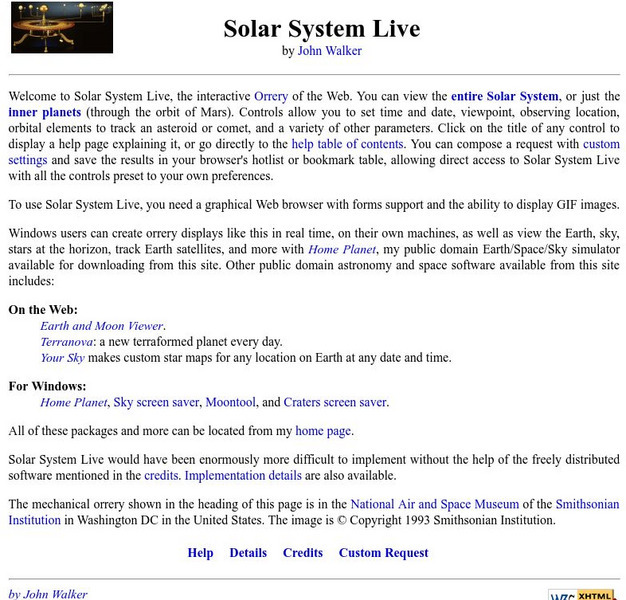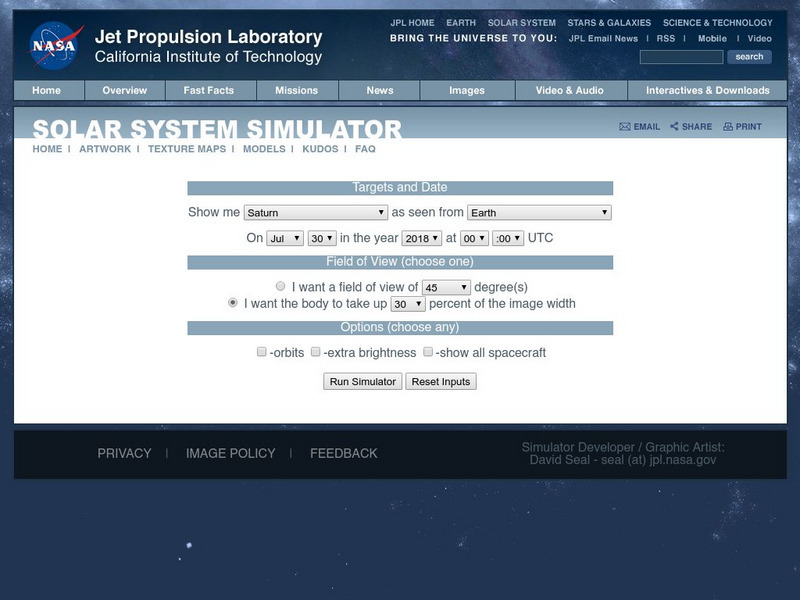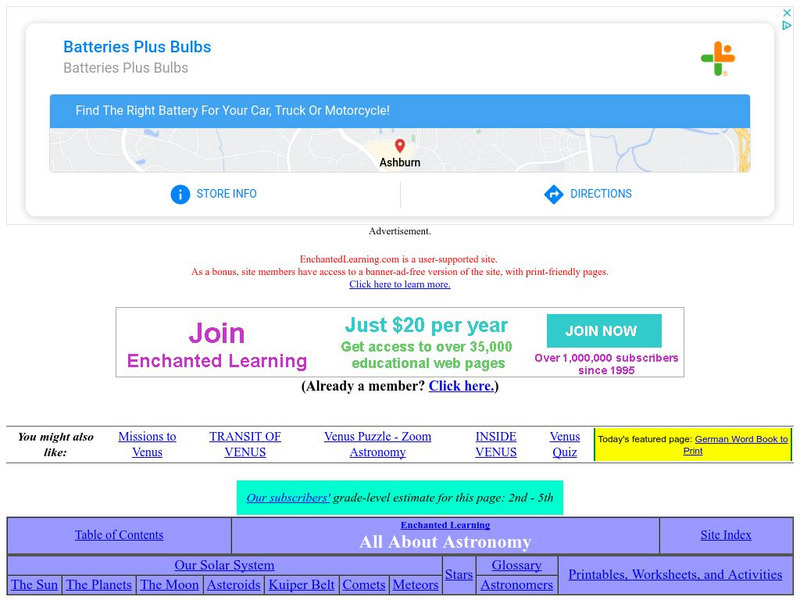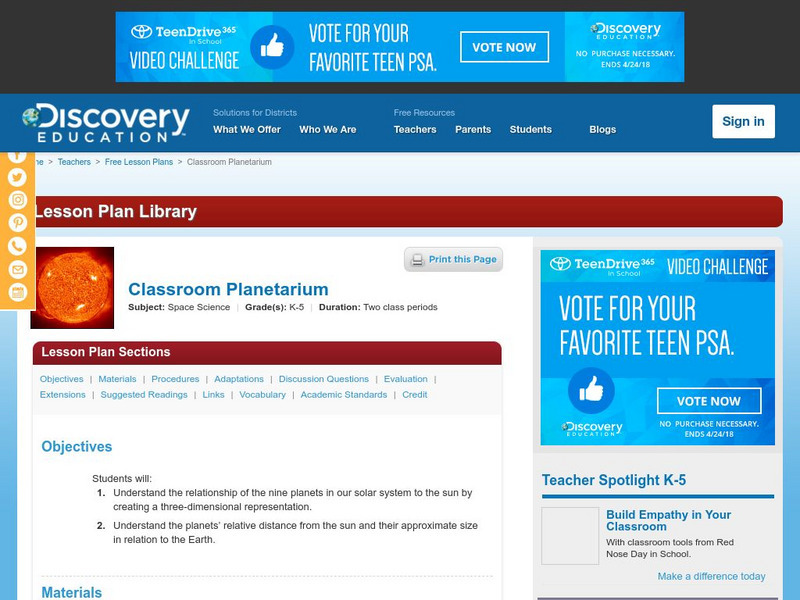Fourmilab Switzerland
John Walker: Solar System Live
This planetarium program allows you to create an accurate model of the solar system with icons or pictures of each planet. You can specify a date in the past or the future, change the viewpoint to any latitude/longitude, and even view in...
NASA
Nasa: Surface Maps of the Solar System
Solar system surface map database. Includes maps of all solid planets and many moons. Maps of gas planets are either based on images taken by Voyager, or are fictitious maps including general storm systems.
Ducksters
Ducksters: Astronomy for Kids: The Planet Earth
This site is astronomy for kids and teachers! Here students can learn about the planet Earth of the Solar System including fun facts, mass, day, year, and distance from the Sun.
NASA
Nasa Star Child: Where Oh Where Does That Little Object Go?
See if you can identify the positions of the 9 planets in our solar system. Take an online quiz and get feedback on your answers.
NASA
Nasa Star Child: The Solar System Shuffle Game
Match the solar system cards with the correct information in this online activity.
Enchanted Learning
Enchanted Learning: All About Space: Venus
All About Space profiles the planet Venus with information about its size, mass, atmosphere, length of day, and the like. Features include interactive activities and learning exercises.
Enchanted Learning
Enchanted Learning: Solar System Find It! Quiz
This Find It! quiz from Enchanted Learning encourages deductive reasoning, dictionary use, and vocabulary building. Used as a small group activity, it can promote cooperative learning.
Nine Planets
The Nine Planets: Chronology of Solar System Discovery
A chronology of Solar System discoveries made from before the 1600s to now.
Natural History Museum
Natural History Museum: Our Place in the Universe
Part of a larger online exhibit on the moon and space, this site deals with one's place in the universe. The topics covered include the sun and solar system, the galaxy, and the universe.
Science Struck
Science Struck: A Scientific Explanation to What Causes Day and Night
Explains how the rotation and the axial tilt of the Earth are responsible for the phenomenon of day and night. Provides information about the Sun, the solar system, and the Earth, and how the circumference of the Earth was first measured...
Other
Sandburg Center for Sky Awareness: What Are the Shapes of the Planets' Orbits?
In this lesson plan investigation students learn about the shapes of the planetary orbits by experimenting with ellipses of different proportions.
Thomas Jefferson National Accelerator Facility
Jefferson Lab: Science Crossword Puzzles Solar System [Pdf]
Find out what you know about the solar system by completing this crossword puzzle!
Ducksters
Ducksters: Kids 10 Question Quiz: Solar System
Kids take a ten question practice quiz on the Solar System on this website.
Discovery Education
Discovery Education: Classroom Planetarium
Create a classroom model of the solar system while teaching about relative size of all the planets, and each planet's distance from the sun.
Other
All (Known) Bodies in Our Solar System Larger Than 200 Miles in Diameter
How big is the Earth compared to the Sun? Is Mars bigger than the Moon? Seeing all bodies in the solar system larger than 200 miles in diameter side by side provides an excellent comparison and an interesting perspective.
Science4Fun
Science4 Fun: Earth
Learn fun facts and details about the geography and composition of Earth, the third closest planet to the sun and the only planet that contains life.
Science4Fun
Science4 Fun: Jupiter
Learn fun facts and details about the weather, composition, and discovery of Jupiter, the largest of all the planets.
Science4Fun
Science4 Fun: Mars
Learn fun facts and details about the weather, geography, composition, and discovery of Mars, the fourth closest planet to the Sun.
Science4Fun
Science4 Fun: Mercury
Learn fun facts and details about the atmosphere, geography, composition, and discovery of Mercury, the closest planet to the sun.
Science4Fun
Science4 Fun: Neptune
Learn fun facts and details about the atmosphere, composition, and discovery of Neptune, the last planet in our solar system.
Science4Fun
Science4 Fun: Pluto
Learn fun facts and details about the atmosphere, geography, composition, and discovery of Pluto, a dwarf planet.
Science4Fun
Science4 Fun: Saturn
Learn fun facts and details about the atmosphere, composition, and discovery of Saturn, the second largest planet.
Science4Fun
Science4 Fun: Uranus
Learn fun facts and details about the atmosphere, composition, and discovery of Uranus, the seventh closest planet to the sun.














